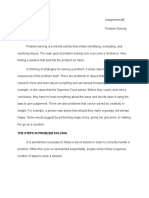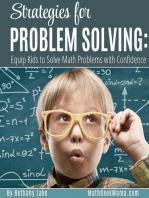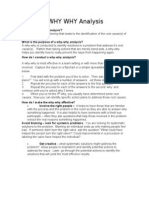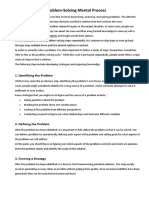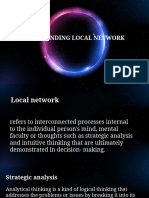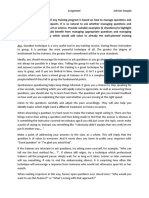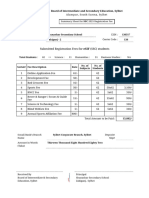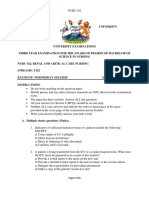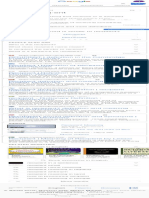0 ratings0% found this document useful (0 votes)
30 viewsProblem Solving Barriers and Its Approaches
Problem Solving Barriers and Its Approaches
Uploaded by
vasu mittalThe document discusses barriers to problem solving and approaches to overcoming them. It identifies 5 common barriers: confirmation bias, mental set, functional fixedness, unnecessary constraints, and irrelevant information. It then provides approaches to better problem solving, such as remaining calm, not overcomplicating issues, using available tools, checking work, and practicing problem solving skills. The overall purpose is to help readers identify and address potential roadblocks in their problem solving.
Copyright:
© All Rights Reserved
Available Formats
Download as PPTX, PDF, TXT or read online from Scribd
Problem Solving Barriers and Its Approaches
Problem Solving Barriers and Its Approaches
Uploaded by
vasu mittal0 ratings0% found this document useful (0 votes)
30 views22 pagesThe document discusses barriers to problem solving and approaches to overcoming them. It identifies 5 common barriers: confirmation bias, mental set, functional fixedness, unnecessary constraints, and irrelevant information. It then provides approaches to better problem solving, such as remaining calm, not overcomplicating issues, using available tools, checking work, and practicing problem solving skills. The overall purpose is to help readers identify and address potential roadblocks in their problem solving.
Original Description:
behvioral science
Original Title
bs
Copyright
© © All Rights Reserved
Available Formats
PPTX, PDF, TXT or read online from Scribd
Share this document
Did you find this document useful?
Is this content inappropriate?
The document discusses barriers to problem solving and approaches to overcoming them. It identifies 5 common barriers: confirmation bias, mental set, functional fixedness, unnecessary constraints, and irrelevant information. It then provides approaches to better problem solving, such as remaining calm, not overcomplicating issues, using available tools, checking work, and practicing problem solving skills. The overall purpose is to help readers identify and address potential roadblocks in their problem solving.
Copyright:
© All Rights Reserved
Available Formats
Download as PPTX, PDF, TXT or read online from Scribd
Download as pptx, pdf, or txt
0 ratings0% found this document useful (0 votes)
30 views22 pagesProblem Solving Barriers and Its Approaches
Problem Solving Barriers and Its Approaches
Uploaded by
vasu mittalThe document discusses barriers to problem solving and approaches to overcoming them. It identifies 5 common barriers: confirmation bias, mental set, functional fixedness, unnecessary constraints, and irrelevant information. It then provides approaches to better problem solving, such as remaining calm, not overcomplicating issues, using available tools, checking work, and practicing problem solving skills. The overall purpose is to help readers identify and address potential roadblocks in their problem solving.
Copyright:
© All Rights Reserved
Available Formats
Download as PPTX, PDF, TXT or read online from Scribd
Download as pptx, pdf, or txt
You are on page 1of 22
Problem solving
barriers and its
approaches
By - Anas Bin Saddik Khan A3104616302
Vasu Mittal A3104616323
Parag Jain A3104616307
Aswad Gul Noori A3104616383
Shlok Gupta A3104616329
B.Com hons.
Section E
Batch of 2016 - 19
Barriers to
problem solving
1. Confirmation bias
2. Mental set
3. Functional fixedness
4. Unnecessary constraints
5. Irrelevant information
Confirmation Bias
This is about not following the problem solving
method, and so introducing bias. This can be the
result of missing steps out, or not using them
correctly. Confirmation Bias arises when the
approach taken is to confirm a preconceived
solution.
Basically, you would have found the solution
before you found the problem, and perceive the
problem solving method through this lens
(perspective and intellectual blocks). For example,
if you feel you already know everything about the
problem, you wont perform research, or only
research things that confirm the appropriateness
of the solution you want to use.
Mental Set
This comes from relying too heavily on heuristics the
clichs of problem solving, like a rule of thumb or
common sense as a way to solve a problem, rather
than actively looking for the best or simplest solution.
It is about reusing what has been successful in the past,
rather than assessing and evaluating the problem.
The heuristic for mental mind set could be called why
reinvent the wheel. It relies on previous experiences to
direct how a problem can be solved. This could be an
intellectual block, as the problem solver is not prepared
to learn new problem solving skills, and emotionally
relies on familiarity to feel comfortable with a solution.
Functional Fixedness
This is about not thinking creatively. It is a narrow
mind-set. Functional Fixedness comes from
people thinking that an object has only one
function.
For example; a jug can only be used to pour fluids;
it cant be used as a mixing bowl. It can be
summarized as You cant do that. Functional
Fixedness affects the time taken to make a
decision. If you dont have a mixing bowl, but
wont use the jug, you waste time going to buy a
new mixing bowl. Because it relates to objects,
often caused by an intellectual or environmental
block.
Unnecessary Constraints
This barrier causes unwarranted boundaries to be placed on
a problem. It links to trying to solve a problem using previous
experience of what has worked in a situation and trying to
force it to work in the current situation, rather than looking
for a new solution.
This inhibits creativity. The barrier can be removed by insight.
Most problem solving methods focus on developing insight
into a problem through information gathering, evaluation
and assessment.
Unnecessary Constraints could be caused by an intellectual
block, or an emotional one causing an over reliance on the
known. An example would be trying to improve a service
using current procedures and processes, rather than find a
solution and design new procedures and processes.
Irrelevant Information
This is information that is not needed to solve the problem, often
caused by people diverging from the problem itself, onto other
topics they feel are related or presenting too much information.
Irrelevant information hinders problem solving as it slows the
process down, can cause confusion or misunderstandings.
A brainstorming session can be impaired because people want to
go off topic. This is why many brainstorming sessions have a
facilitator to get things back on track. When gathering information,
it can be getting distracted and looking at something that is
interesting but not useful. It can result in too much information
being collected, and people having trouble absorbing it.
For example, giving a problem-solving group full copies of all the
information found, rather than summarising it as headlines, a graph
or a mind map.
This could be an expression block people struggle to
summarise the information, an emotional one people fear
they wont have enough information, or even a cultural one
full papers are always presented in meetings.
There are a range of barriers to problem solving based on
cognitive blocks and practical social and physical jobs. These
can be perceptual, emotional, intellectual, expressive,
environmental, cultural.
Cognitive blocks are our ways of thinking and feeling. These
contribute to how we approach and carry out problem
solving, leading to barriers. They usually introduce bias,
errors, and result in imperfect solutions. These barriers can
be removed by awareness of the pitfalls in problem solving,
and training in how to use a problem solving method
correctly.
Approaches to
Problem-Solving
1. Try to remain calm
2. Don't Over-complicate
3. Use Meta-knowledge
4. Use what tools you have
5. Don't let technology be a crutch
6. Figuring out strange problems
7. Be aware of your time
8. Check your work
9. Try to stay focused
10. Practice
11. Every problem has a purpose
Try to remain calm
When you see a problem you don't know
how to do, don't panic.
If you find yourself panicking, try to calm
down; believe in your abilities.
Don't Over-complicate
Start out with the assumption that the
problem will be easy
It's easier to start this way and be proven
wrong than to start thinking it's hard and be
prove right.
If you know that something always has the
same answer and need to find that answer,
try checking the simplest example.
If an equation always has the same value, try
plugging in a number that will make things
simple (like 0 or 1)
Use Meta-knowledge
Sometimes there is additional information
at your disposal hidden nearby.
If you're in a chapter about x, it stands to
reason that you will have to do something
related to x.
Other, similar problems often have useful
information.
Use what tools you have
If you haven't learned a skill, it is unlikely
you will be able to use it on a problem.
Material from later chapters in a textbook
should not be required to do problems
from earlier chapters
We live in the information age, if nobody
seems able to help, you can still try
learning on your own.
Don't let technology be a crutch
Technology is around to make our lives
easier. If your technology is doing
something for you that you don't
understand, it is not doing what it is
supposed to.
Even assuming you always have the
technology to do something nearby,
knowing how it works will make you
better able to use it.
Figuring out strange problems
Try to apply what you know until you get
somewhere
The problem might be a weird phrasing of
an easy problem.
Try to figure out any implications of the
given information
Be aware of your time
If a problem is taking too long, you may be
thinking about it the wrong way
If you have a set amount of time to do the
problem (such as on a test), you may have
to decide if the problem is worth your
time
Don't rush through the problem
Simple mistakes are even easier to make
when you go too fast
Check your work
Make sure everything matches up after
each step you take (it's easy to lose a
symbol somewhere).
Sometimes it is better to have someone
else check your work so that your mind
doesn't fill in any gaps
Try to stay focused
If you find yourself spacing out, try
approaching your problem from another
perspective
If you really can't seem to keep your mind
on the problem, you may want to take a
break if you have the time
Practice
As with most things, the more you
practice, the more you hone your
problem solving skill
As you practice, your understanding will
likely also improve
Every problem has a purpose
Just because you can't see the purpose
doesn't mean it isn't there.
Some purposes are more trivial than
others.
You might also like
- The Lord's Prayer OutlineDocument7 pagesThe Lord's Prayer Outlinemaddogyp100% (2)
- Hypothesis Testing Random Motors ProjectDocument6 pagesHypothesis Testing Random Motors ProjectMohammed Mehran100% (3)
- Moot Memorial On AadharDocument30 pagesMoot Memorial On Aadharmadhu50% (8)
- What Defines Critical Thinking and How Do We Start Thinking Critically?Document33 pagesWhat Defines Critical Thinking and How Do We Start Thinking Critically?Sankalp ShandilyaNo ratings yet
- Barriers To Problem SolvingDocument14 pagesBarriers To Problem SolvingMARRYCHRES MEDINANo ratings yet
- Problem SolvingDocument3 pagesProblem SolvingJeff KingNo ratings yet
- 51 - Problem SolvingDocument4 pages51 - Problem SolvingMicu Zambrotta DanielNo ratings yet
- CognitionDocument35 pagesCognitionHaroonNo ratings yet
- CavidanTagizade Oxuyub Anlama.Document12 pagesCavidanTagizade Oxuyub Anlama.Cavidan 000No ratings yet
- Definition of Rpoblem SolvingDocument4 pagesDefinition of Rpoblem SolvingKyla MariñoNo ratings yet
- Problem Solving Method of TeachingDocument5 pagesProblem Solving Method of TeachingTriviaNo ratings yet
- Problem SolvingDocument3 pagesProblem SolvingirinafandulNo ratings yet
- Decision Making and Problem SolvingDocument21 pagesDecision Making and Problem SolvingTeresiah MainaNo ratings yet
- Assignment#6 BalaniDocument4 pagesAssignment#6 BalaniErika BalaniNo ratings yet
- Problem solving-WPS OfficeDocument2 pagesProblem solving-WPS OfficeJamil GutierrezNo ratings yet
- ProcrastinationDocument3 pagesProcrastinationapi-321241961No ratings yet
- For MPD Journal...Document18 pagesFor MPD Journal...UdanniNo ratings yet
- Organizing A Work Routine: Work Routines May Also Include The Following TasksDocument5 pagesOrganizing A Work Routine: Work Routines May Also Include The Following TasksBEO.Teacher ChuNo ratings yet
- Behaverioul ScienceDocument5 pagesBehaverioul SciencesikarwarrajthakurNo ratings yet
- Topics For LacDocument12 pagesTopics For LacKate BatacNo ratings yet
- Strategies for Problem Solving: Equip Kids to Solve Math Problems With ConfidenceFrom EverandStrategies for Problem Solving: Equip Kids to Solve Math Problems With ConfidenceNo ratings yet
- Cognitive Psychology NotesDocument10 pagesCognitive Psychology NotesnausheenalinizamiNo ratings yet
- Problem Solving and Creative Thinking Module-1 Thinking As A Tool For Problem SolvingDocument14 pagesProblem Solving and Creative Thinking Module-1 Thinking As A Tool For Problem SolvingLightning -VIDEOSNo ratings yet
- PSCT NotesDocument14 pagesPSCT NotesMd AdilNo ratings yet
- Critical Thinking and Problem Solving Advanced Strategies and Reasoning Skills To Increase Your Decision Making A Systematic Approach To Master Logic Avoid Mistakes and Be A Creative Problem SoDocument115 pagesCritical Thinking and Problem Solving Advanced Strategies and Reasoning Skills To Increase Your Decision Making A Systematic Approach To Master Logic Avoid Mistakes and Be A Creative Problem SoKing SriramNo ratings yet
- Mgt. Lecture 2Document11 pagesMgt. Lecture 2monsourjay.gregorioNo ratings yet
- Module MMW Problem Solving Midterm - 024441Document5 pagesModule MMW Problem Solving Midterm - 024441jayannmariepadila286No ratings yet
- Why Problem-Solving Skills Are ImportantDocument5 pagesWhy Problem-Solving Skills Are Importantibreex alyyNo ratings yet
- Overcoming and Understanding ProcrastinationDocument2 pagesOvercoming and Understanding Procrastinationmuhammed eddyNo ratings yet
- Whywhy L2Document2 pagesWhywhy L2Ziaul OnimNo ratings yet
- 16 Statements To Answer: Not at All Rarely Some Times Often Very OftenDocument5 pages16 Statements To Answer: Not at All Rarely Some Times Often Very OftenshalininelsonNo ratings yet
- Problem Solving: Lecture Notes: Part I. Types of ProblemsDocument6 pagesProblem Solving: Lecture Notes: Part I. Types of ProblemsVenice izza VenancioNo ratings yet
- Discipline 1Document3 pagesDiscipline 1carlo aqueNo ratings yet
- 10a UWE Design Thinking Kit - 0. Getting StartedDocument14 pages10a UWE Design Thinking Kit - 0. Getting Startedcehern1997No ratings yet
- Cognitive Psychology Unit 3 BDocument8 pagesCognitive Psychology Unit 3 BazkaNo ratings yet
- Article #3: Simple Right? But What Techniques Help To Create Ideas and Allow For Expression?Document3 pagesArticle #3: Simple Right? But What Techniques Help To Create Ideas and Allow For Expression?daphnereezeNo ratings yet
- CCPS Module - 4Document58 pagesCCPS Module - 4sofia janitNo ratings yet
- Making Quick DecisionsDocument7 pagesMaking Quick DecisionsArmen AlaverdyanNo ratings yet
- Problem Restatement From Thinker's ToolkitDocument6 pagesProblem Restatement From Thinker's ToolkitHIMYM FangirlNo ratings yet
- Problem DefintionDocument2 pagesProblem DefintionPriyanka DNo ratings yet
- Topic 5 Creative Problem SolvingDocument44 pagesTopic 5 Creative Problem SolvingPREMIUM2023No ratings yet
- The Best 6 Step To Be A Problem SolverDocument3 pagesThe Best 6 Step To Be A Problem SolverElaixa SibandaNo ratings yet
- A Mind For NumbersDocument5 pagesA Mind For NumbersSammi GohNo ratings yet
- Behaviour Science Module 3 AmityDocument2 pagesBehaviour Science Module 3 AmityishanNo ratings yet
- Problem Solving Skills skillsYouNeed PDFDocument8 pagesProblem Solving Skills skillsYouNeed PDFnpNo ratings yet
- UVic Math Study TipsDocument2 pagesUVic Math Study Tipst.w.c.No ratings yet
- Edaño (Report)Document24 pagesEdaño (Report)Bryan MamucayNo ratings yet
- Bản Dịch Bài 12 - Kỹ Năng Giải Quyết Vấn Đề - English - TranslatedDocument4 pagesBản Dịch Bài 12 - Kỹ Năng Giải Quyết Vấn Đề - English - Translated10.3108 Lê Trúc HạNo ratings yet
- Reasons Why We Use Visual Thinking For Problem SolvingDocument7 pagesReasons Why We Use Visual Thinking For Problem SolvingakhilNo ratings yet
- Uses For Creative Problem Solving SkillsDocument3 pagesUses For Creative Problem Solving SkillsNivedita PatilNo ratings yet
- Understanding Local Network Group 1Document13 pagesUnderstanding Local Network Group 1kq7bz6qhr4No ratings yet
- Paper 5 Assignment Ashwini GangalaDocument6 pagesPaper 5 Assignment Ashwini Gangalajaikrishna gangala100% (2)
- Pushing Through The ProblemDocument27 pagesPushing Through The Problemzoranle2363No ratings yet
- DocumentDocument4 pagesDocumentMod HollNo ratings yet
- Problem solving in 4 steps: How to understand and deal with problems using the best strategies from psychology and decision scienceFrom EverandProblem solving in 4 steps: How to understand and deal with problems using the best strategies from psychology and decision scienceNo ratings yet
- Problem SolvingDocument9 pagesProblem SolvingCristina RîndașuNo ratings yet
- Problem SolvingDocument9 pagesProblem SolvingHussein SaddamNo ratings yet
- 1.1. Problem-Solving TechniquesDocument6 pages1.1. Problem-Solving TechniquesPhát TrầnNo ratings yet
- Solving Problem 1Document9 pagesSolving Problem 1Jeanen Claire VeraNo ratings yet
- Subject: Practical Research II: Page 1 of 22Document22 pagesSubject: Practical Research II: Page 1 of 22Alexis CastilloNo ratings yet
- Chapter 4 Conceptual DesignDocument93 pagesChapter 4 Conceptual DesignBereket yikeberNo ratings yet
- RDBMSDocument17 pagesRDBMSNadim MominNo ratings yet
- Azizul Hakim ,: Admitted FactDocument5 pagesAzizul Hakim ,: Admitted FactALIFNo ratings yet
- Pedigree AnalysisDocument11 pagesPedigree Analysismzunl25476No ratings yet
- (English) Timothy Goes To School - Timothy Goes To School - Yoko - Ep.1 (DownSub - Com)Document18 pages(English) Timothy Goes To School - Timothy Goes To School - Yoko - Ep.1 (DownSub - Com)Diem DXNo ratings yet
- Diversity in Ethiopia: A Historical Overview of Political ChallengesDocument16 pagesDiversity in Ethiopia: A Historical Overview of Political Challengesaregawi selemonNo ratings yet
- Class 9 Reg FinalDocument7 pagesClass 9 Reg Finalexclaimkamrul3No ratings yet
- CapstoneDocument3,306 pagesCapstoneVan Sj TYnNo ratings yet
- Daz Error LogDocument72 pagesDaz Error LogRyan FogartyNo ratings yet
- People v. Artoza y Katang-KatangDocument2 pagesPeople v. Artoza y Katang-Katangf919No ratings yet
- Hapag Lloyd: Internship ReportDocument18 pagesHapag Lloyd: Internship ReportTara Tabbassum JohnNo ratings yet
- Action Plan: Name of Organization/ ClubDocument3 pagesAction Plan: Name of Organization/ ClubJared CoyagboNo ratings yet
- The True Sabbath PDFDocument32 pagesThe True Sabbath PDFEugenius Divine LoveNo ratings yet
- Imaging and Design For Online EnvironmentDocument9 pagesImaging and Design For Online Environmentnielamp4s0 -No ratings yet
- 9 3 2023-DUCY Minutes-of-MeetingDocument5 pages9 3 2023-DUCY Minutes-of-MeetingJunlie Gomez CabatinganNo ratings yet
- Reading Explorer 3E - Level 3 - CEFR CorrelationDocument59 pagesReading Explorer 3E - Level 3 - CEFR CorrelationyylamNo ratings yet
- 64 - Mindtree Brochures Murex Datamart Performance Optimization PDFDocument4 pages64 - Mindtree Brochures Murex Datamart Performance Optimization PDFpurushottam100% (1)
- Thesis Coffee ShopDocument4 pagesThesis Coffee Shopcrystalwilliamscleveland100% (2)
- CESC Q4 Lesson 3 PDFDocument37 pagesCESC Q4 Lesson 3 PDFCherryl MarigocioNo ratings yet
- The Impact of Humor in Advertising: A Review: Marc G. Weinberger and Charles S. GulasDocument26 pagesThe Impact of Humor in Advertising: A Review: Marc G. Weinberger and Charles S. GulasSujal RaneNo ratings yet
- Cambaliza Vs Cristobal-TenorioDocument6 pagesCambaliza Vs Cristobal-TenorioDora the ExplorerNo ratings yet
- Parametric DifferentiationDocument14 pagesParametric DifferentiationAmeyRuled AriffinNo ratings yet
- Nuru 342 - Critical Care and RenalDocument4 pagesNuru 342 - Critical Care and RenalIshak IshakNo ratings yet
- Antecedents of Statistics Anxiety Among Senior High School StudentsDocument10 pagesAntecedents of Statistics Anxiety Among Senior High School StudentsPsychology and Education: A Multidisciplinary JournalNo ratings yet
- Recipient Means - Google Search PDFDocument1 pageRecipient Means - Google Search PDFyannaNo ratings yet
- Release Final - João GordoDocument2 pagesRelease Final - João GordoHomero JanuncioNo ratings yet
- Overview of Anesthesia - UpToDateDocument11 pagesOverview of Anesthesia - UpToDateFernandoVianaNo ratings yet













